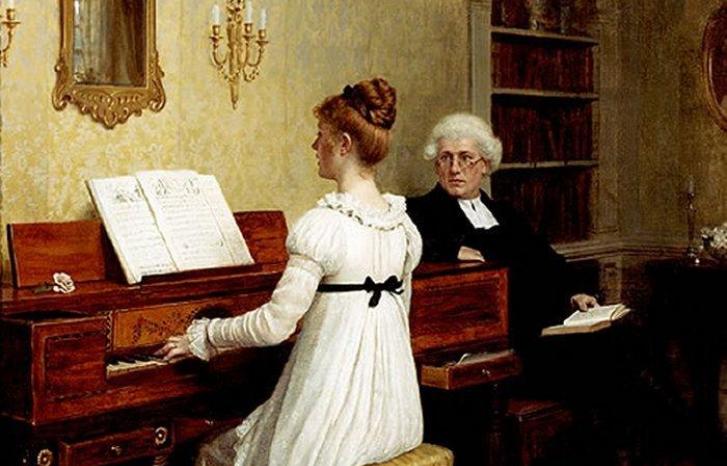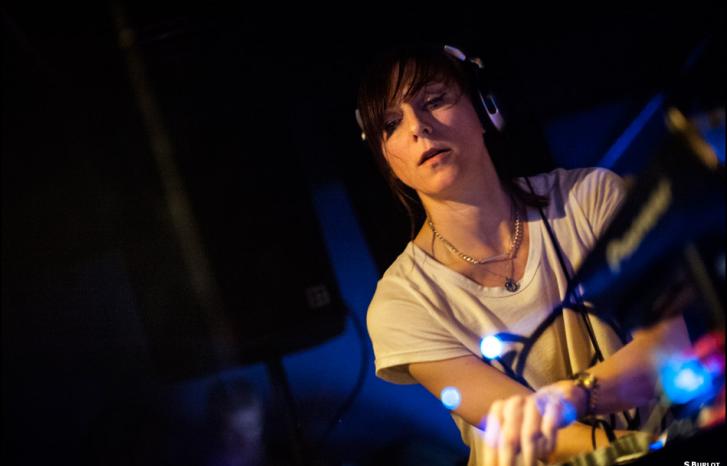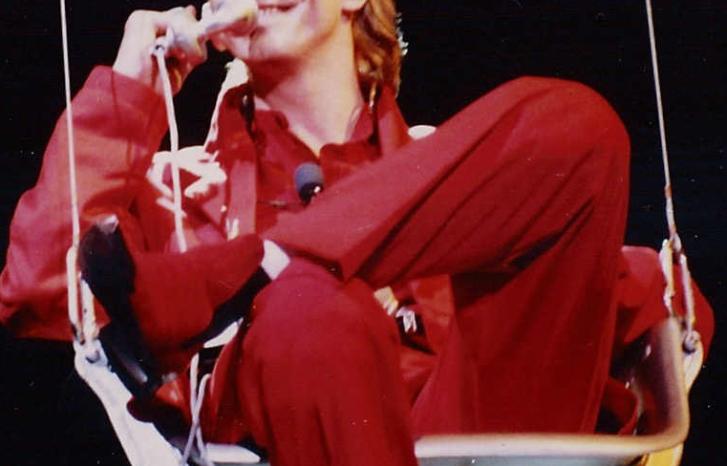Being openly homosexual has become easier and easier in Norway. Today the public discourse is emphasising the inclusion of LGBTQ people. However, very few known pop musicians in Norway are openly homosexual.
“We have no Norwegian Bowie,” Agnete Eilertsen declares. She recently defended her PhD thesis in musicology at University of Agder.
“On the one hand, we’re very keen to be tolerant and inclusive toward everybody, but on the other hand we’re also very compliant. Perhaps it is difficult to be a queer artist in Norway.”
When Nils Bech performed in the TV series SKAM, and was subsequently invited to guest one of NRK’s most high-rated TV shows Kvelden før kvelden (The night before the night), he became known to the general Norwegian audience. Although he is almost the only queer artist in the Norwegian mainstream music scene, seeing Norwegian pop musicians break with traditional expectations to gender roles and sexual identity is nevertheless common. This is what Eilertsen has explored in her thesis.
“Queer expressions and queerness have become an important part of the mainstream pop culture over the last years.”
In her PhD, Eilertsen has studied how musicians who appear as heterosexuals apply elements from queer culture to experiment with gender and sexual identity. However, playing with queerness is not necessarily the same as breaking norms, according to the researcher.
Queer and straight at the same time
Lesbian and gay people were for a long time left to underground music scenes, and queerness belonged to the subcultures. This is no longer the case, according to Agnete Eilertsen.
“Queer gender expressions and self-representations inspired by queer culture have become a fairly central part of the pop culture.”
The core of the concept straight is the idea that women are always feminine and always heterosexual.

In order to analyse openly heterosexual artists who experiment with queer elements in their music and ways of self-representations, Agnete Eilertsen has applied the term straight-queering. It describes a duality in the artists, in which they are both queer and straight at the same time. In her opinion, the English term is best suited.
“These words say something about how it is right for men and women to behave and how it is right to present oneself as a sexual being in public.”
Ground-breaking KUUK
The musicians that Eilertsen has studied represent different genres and niches within Norwegian music. KUUK is a hip-hop group which also makes use of references to DIY punk. Front figures Mira Berggrav Refsum and Ragna Solbergnes rap in Norwegian about sex, alcohol and promiscuity. In addition to being musicians, they are also declared feminists. For example, they have addressed the representation of women in music in newspapers and in a TED-talk, and they have whole-heartedly supported the LGBTQ+ community through the social media and various live performances. Nevertheless, they are best known for their energetic concerts and music videos filled with party, aggression, sex and violence.
“KUUK’s straight-queering is rooted in their desire to demonstrate their support for queer culture. Their straightness is primarily expressed through their lyrics, which refer to heterosexual relationships and sex. The queerness is expressed through the ways in which they represent their femininity,” says Eilertsen.
“They rebel against the norms of femininity. They are in-your-face aggressive, they play on aversion, they are active and full on. This comes to show in their body language in music videos and on stage, but also in the way in which they use their voices and construct their music, with hard, heavy beats, heavy bass and fuzz guitar.”
It is the ground-breaking aspect of KUUK that makes them queer, according to Eilertsen.
“The core of the concept straight is the idea that women are always feminine and always heterosexual. The women in KUUK appear as heterosexual, but they refuse to be traditional, feminine women. Thus they disrupt the image and queer their own performance.”
Queer normality
Singer-songwriter Kaja Gunnufsen’s appearance is completely contrary to the aggressive rappers in KUUK. Her low-key style has been called quirky and normcore because she is slightly weird but also very normal. She sings relatively plain pop songs about being unsuccessful in most things in life, and even the cover photo on her debut album Faen Kaja is ‘unsuccessful’ – taken while she is blinking her eyes.
“Kaja Gunnufsen does not necessarily play on gender, sexual otherness or queerness, but rather on weirdness. She keeps an ironic distance that makes her more interesting,” says Eilertsen.
By exaggerating she demonstrates that what is considered normal is also constructedt.

“This also affects how we perceive her as a gendered, feminine woman. On the one hand, she is straight, because she has a very traditional appearance and a girly voice, and because she makes music within a female dominated genre. But on the other hand, she appears as caricatured and ironic, which are strategies known from the queer community.”
When Kaja Gunnufsen exaggerates the girly and traditionally feminine and exerts herself to be normal, she almost becomes what the queer community calls camp, according to Eilertsen.
“By exaggerating she demonstrates that what is considered normal is also constructed and something you actively have to do.”
Lars Vaular – family father and norm breaker
These days you can watch the mini-series En ekte mann (‘A Real Man’) online. Here, rap artist Lars Vaular explores what it means to be a man today, and this is not the first time he challenges the male gender role through his art.
“Lars Vaular seems to be a master of playing with various discourses, and he uses queer gender expressions in order to challenge norms within the Norwegian rap scene,” says Eilertsen.
During his ten year-long career, the artist from Bergen has released five solo albums, a number of singles and collaborative projects with other artists both from the hip-hop scene in Bergen and from Norway in general. He has received awards and praise for his lyrics, for breaking with traditional genres and for his aesthetics. Outward, through the social media, he appears as a straight family father. According to Agnete Eilertsen, this contributes to the duality of his style.
“He seems very conscious of gender, and it seems like he has read queer theory.”
The way in which queerness enters straight culture is a step forward, as it demonstrates that norms for what are regarded as acceptable expressions of gender and sexuality are changing.
His music video «Det ordner seg for pappa» ('Daddy will be all right') received mixed reactions when it appeared in 2015, but he received much praise for the ways in which he challenged traditional gender roles. The video shows Vaular dancing contemporary dance, mixing in elements from queer styles such as vogueing, and he is singing instead of rapping. Eilertsen sees a clear reference to queer artists in his performance.
“At the same time, it is calculated,” she adds.
“He uses a gendered otherness in order to achieve more credibility. He does this by playing on the myth of the autonomous artist who does exactly what he feels like, among other things. Ironically, this is a fairly typical traditional masculine stereotype that furthers his career.”
See also: Cash's masculine vulnerability
Pop culture reflects society
According to Eilertsen, the fact that heterosexual artists can experiment freely with queer gender expressions says a lot about Norwegian society.
“Pop culture is a window into the larger culture, and is often a caricatured version of the culture in which it has emerged. You can learn much about a society by studying its pop culture, but you need to know something about the context. Norwegian artists are influenced by foreign artists, but at the same time there are a number of things that are specific for Norwegian culture.”
The norms related to how to be a man or a woman particularly influence the musicians.
“The gender norms differ within the various genres and within various local music scenes. In addition, there are norms that apply to society in general. For instance, KUUK challenges the male dominated rap scene and how women are portrayed in hip-hop, and consequently the norms for femininity in general society. You need to see all these perspectives all at once – the genre and society as a whole.”
Experimenting or appropriating?
When someone from a culture uses aesthetics or expressions from another culture, it is sometimes termed ‘cultural appropriating’. When those belonging to majority groups borrow from minorities, it is often problematised. In her PhD thesis, Eilertsen discusses whether what heterosexual musicians do – that they make themselves interesting through the use of queer expressions – may be called appropriating, or whether it is an effective mix of expressions that may affect norms.
“I think it is both,” she declares.
“The way in which queerness enters straight culture is a step forward, as it demonstrates that norms for what are regarded as acceptable expressions of gender and sexuality are changing and that we are perhaps moving towards a more open society where otherness is tolerated and accepted to a larger extent.”
“At the same time, that queerness becomes mainstream may also take the edge off queer activism. Queerness becomes just a part of the commercial pop machinery. Then, instead of breaking norms and changing society, it may become a way of aestheticising the gender discourse in such a way that it increases the artist’s popularity without actually challenging anything.”
Lars Vaular challenges genre conventions related to how he is perceived as a man.
– Når heteroseksuelle artister bruker visse skeive uttrykk, påvirker det hva som er den ok måten å være skeiv på eller uttrykke skeivhet på i offentligheten?
“When heterosexual musicians use certain queer expressions, does that affect what is considered the right way of being queer or the right way of expressing queerness in public?”
“The norms govern our ways of behaviour, and queerness will always challenge the norms. When certain forms of queerness are accepted, they become part of the straight society. Then queerness must become something new, since what is considered queer changes constantly.”

Balancing act
A common feature for all the three artists that Eilertsen has analysed is that their expression is ambiguous. They balance between genres, between irony and sincerity, between straightness and queerness.
“Ambiguity is the key to queerness. If you become insecure in your encounter with something and don’t quite know how to label it, then it is queer. When musicians are ambiguous in the way in which they approach their genre and their community, then we also become confused about how they perform gender.”
“Lars Vaular challenges genre conventions related to how he is perceived as a man. We don’t quite know whether he is a rapper or a pop singer, and consequently he becomes a different and more feminine figure, a more feminine artist.”
“But although Lars Vaular experiments with gender identities he still makes sure to demonstrate that he is a heterosexual man.”
“This is the most typical characteristic of straight-queering. They push boundaries, play a little, but at the same time they feel a strong need to say that ‘I do this because I want to play with gender’ without taking the whole risk. Appearing queer may also involve the risk of being socially excluded or losing one’s position. The way Vaular does it he constantly saves himself. Thus he appears very open, modern and progressive – which helps his career.”
“All the artists you analyse are heterosexual, white and safely positioned socially. How does that affect the way in which their gender identity is perceived?”
“Their whiteness and their social position are part of their straightness. They don’t just appear heterosexual; they are also part of the majority. This gives them more wiggle-room to experiment without risking too much. They’re secure and know how to present themselves in order to appear correctly.”
Gender diversity more than men and women
Every summer there is the discussion concerning gender balance and Norwegian music festivals. Eilertsen’s perspective indicates that gender diversity may be about more than just a 50/50 distribution of women and men.
“I would like to see more of the out-of-the-closet-queer artists enter the mainstream music. There exists a subculture of queer artists who should be included in the discussion on gender distribution. It is important with more women artists in the music festivals, but the discussion is very limited. We need a wider perspective and we need to include more varied gender expressions as part of the diversity.”
Eilertsen’s research demonstrates that the gender norms are changing.
“At the same time it demonstrates that gender identities may be used for commercial purposes,” she says.
“Most importantly, it shows that gender is a social construction, that it is possible to play and experiment with gender identities, and that this has become an integrated part of the larger public discourse on gender and sexuality in Norway.”



